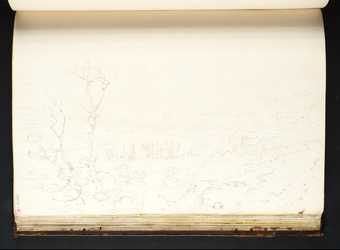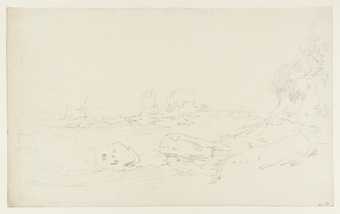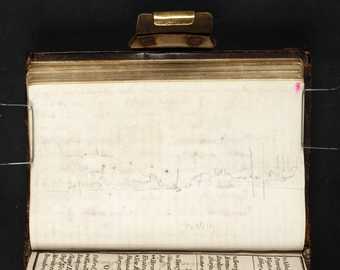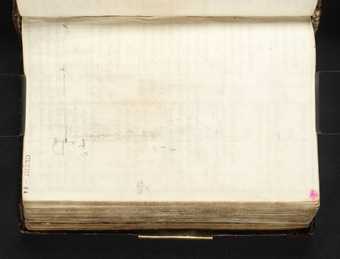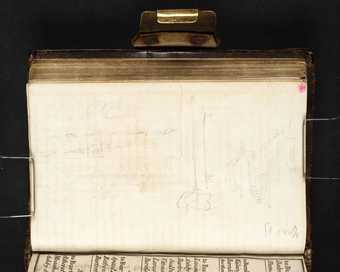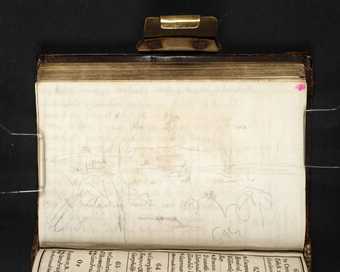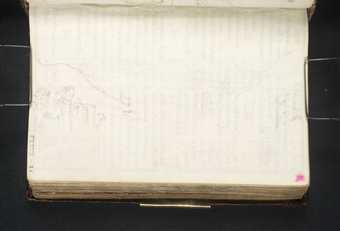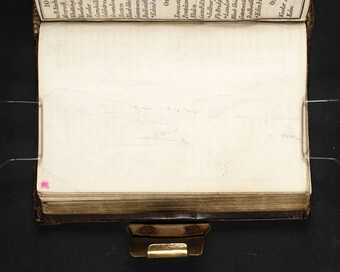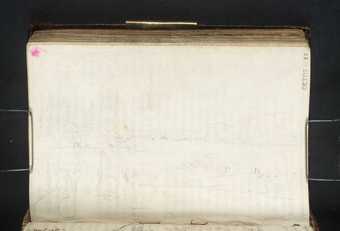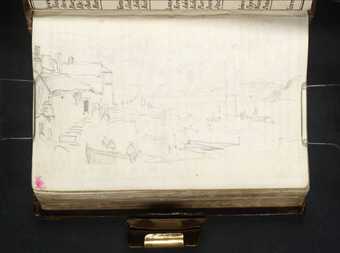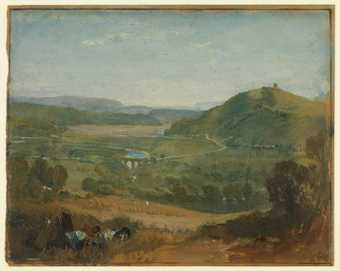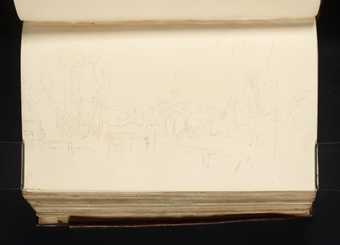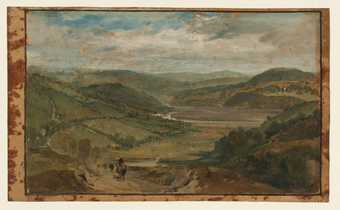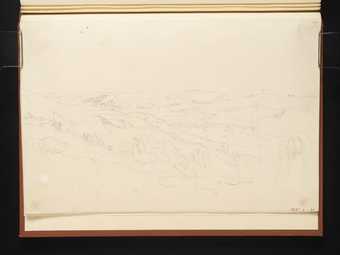
In Tate Britain
Prints and Drawings Room
View by appointment- Artist
- Joseph Mallord William Turner 1775–1851
- Medium
- Oil and chalk on paper
- Dimensions
- Support: 158 × 257 mm
- Collection
- Tate
- Acquisition
- Accepted by the nation as part of the Turner Bequest 1856
- Reference
- D09216
Turner Bequest CXXX J
Display caption
In Devon in the summer of 1813,
when the weather was exceptionally
fine, Turner made a series of outdoor sketches. He was encouraged by a local artist, Ambrose Johns, who provided him with the necessary materials: a 'portable painting- box' and sheets of prepared paper. Of the fifteen known today, twelve are in Tate's Collection. Turner is said to have made them very quickly, claiming that one took him less than half an hour. He used thinly diluted oil, over preliminary outlines in chalk. This view of limekilns
at Crabtree was made near the east entrance to Saltram Park.
Gallery label, September 2004
Does this text contain inaccurate information or language that you feel we should improve or change? We would like to hear from you.
Catalogue entry
[from] Nos. 213–25: Devonshire Sketches, 1813
THIS group of oil sketches on paper of Devonshire subjects has always been associated with Turner's second visit to Devon. His first had been in the summer of 1811 and the second is dated by Finberg to the summer of 1813; the chief evidence lies in the later account of Cyrus Redding, whose reference to the visit of the singer Madame Catalani to Saltram can presumably be linked with her known appearances at Exeter and Truro in August 1813. The same journey lay behind Turner's Crossing the Brook, exhibited in 1815 (see No. 130 [N00497]). Turner also seems to have visited south Devon in 1814 (see Gage 1980, pp. 57–9).
Redding describes a picnic on the heights of Mont Edgcumbe at which ‘Turner showed the ladies some of his sketches in oil, which he had brought with him, perhaps to verify them’. This could suggest that they had been executed indoors, but on the other hand, as Evelyn Joll has pointed out, Turner may have painted them on a previous excursion and now wished to check the exact locations. Indeed, another companion, Charles (later Sir Charles) Eastlake, told Thornbury how, when Turner 'returned to Plymouth, in the neighbourhood of which he remained some weeks, Mr. Johns [Ambrose Johns, 1776–1858, a local landscape painter] fitted up a small portable painting-box, containing some prepared paper for oil sketches, as well as the other necessary materials. When Turner halted at a scene and seemed inclined to sketch it, Johns produced the inviting box, and the great artist, finding everything ready to his hand, immediately began to work. As he sometimes wanted assistance in the use of the box, the presence of Johns was indispensible, and after a few days he made his oil sketches freely in our presence. Johns accompanied him always; I was only with them occasionally. Turner seemed pleased when the rapidity with which those sketches were done was talked of; for, departing from his habitual reserve in the instance of his pencil sketches, he made no difficulty of showing them. On one occasion, when, on his return after a sketching ramble, to a country residence belonging to my father near Plympton, the day's work was shown, he himself remarked that one of the sketches (and perhaps the best) was done in less than half an hour.
‘When he left Plymouth, he carried off all the results. We had reckoned that Johns who had provided all the materials, and had waited upon him devotedly, would at least have had a present of one or two of the sketches. This was not the case; but long afterwards, the great painter sent Johns in a letter a small oil sketch, not painted from nature, as a return for his kindness and assistance [see No. 225]. On my inquiring afterwards what had become of those sketches, Turner replied that they were worthless, in consequence, as he supposed of some defects in the preparation of the paper; all the grey tints, he observed, had nearly disappeared. Although I did not implicitly rely on that statement, I do not remember to have seen any of them afterwards’. These sketches are presumably Nos. 213–25b.
Although the support is described by Finberg as prepared board it seems rather to be a heavy paper, prepared on one side with an oil medium. In one case there is an unfinished composition on the unprepared verso (No. 214 [D09208 and D40096]); in another, Turner's only sketch is on the unprepared side of the paper (No. 220 [D09214]). According to Finberg the reverse of No. 213 [D09207], which is now stuck down, bears the printed title of what seems to be the 1808 Prospectus for The British Gallery of Pictures, not finally published until ten years later but for which J. Fittler engraved the Bridgewater Seapiece (No. 14) with the date 1 July 1812. This suggests that Turner, or rather Johns, may have torn suitably blank areas of paper from this publication and then prepared them for the sketches. All the sheets except No. 217 [D09211] measure approximately the same size, the exception being double that size, and most seem to have been torn down the left-hand edge as if from a book. However, No. 213 [D09207] is on a paler toned paper than the rest, which may therefore come from another source.
The identification of the views used here were kindly supplied by Dr S.A. Smiles of the Exeter College of Art and Design in a letter of 28 January 1984. All these sites seem to be within easy range of Plymouth.
Lit. Cyrus Redding, Fifty Years' Recollections 1858, i, pp. 199–205; Thornbury 1862, i, pp. 219–20; 1877, p. 153; Finberg 1909, i, pp. 364–5; 1961, pp. 197–203; Gage 1969, pp. 38–9; Wilton 1979, pp. 109–11.
222. [D09216] On the Plym Estuary near Crabtree 1813
THE BRITISH MUSEUM, LONDON (CXXX-J)
Oil over black chalk, approx. 6 × 9 1/4 (15 × 23·5), on prepared paper, irregular, 6 5/16 × 10 1/8 (16 × 25·7)
Coll. Turner Bequest 1856.
Exh. Paris 1972 (289b); Turner and Watercolour Arts Council tour, April–September 1974 (14).
Previously entitled ‘Barges’.
Published in:
Martin Butlin and Evelyn Joll, The Paintings of J.M.W. Turner, revised ed., New Haven and London 1984
Explore
- architecture(30,960)
-
- industrial(2,075)
-
- kiln(35)
- UK cities, towns and villages(12,725)
-
- Crabtree(1)
- Devon(648)
- England(19,202)
- England, South West(3,507)
- England, Southern(8,982)
- Plym Estuary(3)
- transport: water(8,015)
-
- boat - non-specific(2,203)
- mast(153)
You might like
-
Joseph Mallord William Turner The Estuary of the Mawddach
1798 -
Joseph Mallord William Turner An Island in the Severn Estuary near Beachley
1798 -
Joseph Mallord William Turner Fowey and Polruan from the Estuary
1811 -
Joseph Mallord William Turner Exmouth and the Exe Estuary
1811 -
Joseph Mallord William Turner Starcross on the Exe Estuary; Babbacombe Bay from near Dawlish
1811 -
Joseph Mallord William Turner ?The Exe Estuary near Cockwood
1811 -
Joseph Mallord William Turner Dartmouth Castle and Kingswear down the Dart Estuary
1811 -
Joseph Mallord William Turner The Teign Estuary from near Kingsteignton
1811 -
Joseph Mallord William Turner The Teign Estuary from near Kingsteignton
1811 -
Joseph Mallord William Turner The Laira (Plym Estuary) near Saltram Park with Plymouth Beyond
1811 -
Joseph Mallord William Turner A Mooring on a River or Estuary, Perhaps the Hamoaze
1811 -
Joseph Mallord William Turner The Plym Estuary from Boringdon Park
1813 -
Joseph Mallord William Turner Kingsbridge from the Estuary
1813 -
Joseph Mallord William Turner The Plym Estuary Looking North
1813 -
Joseph Mallord William Turner Padstow and the Camel Estuary
1811

